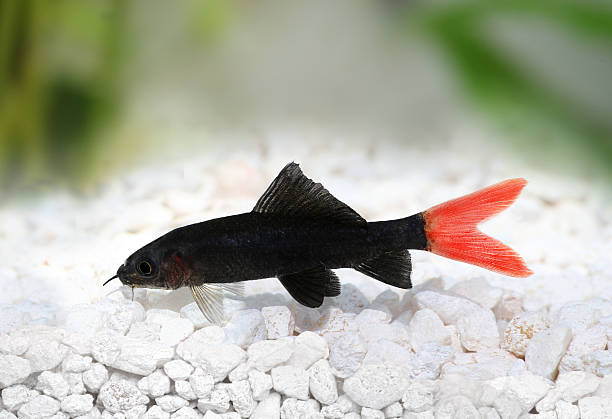Red Tail Shark Care, Food, Tank Mates, & More

In the diverse world of freshwater aquariums, the Red Tail Shark (Epalzeorhynchos bicolor) stands out as a striking and popular choice among hobbyists. Despite their semi-aggressive nature, these fish captivate with their vivid colors and dynamic behavior. This guide delves into the essential care requirements, helping you ensure a thriving environment for these unique fish.
Understanding Red Tail Sharks
Origin and Appearance
Native to Thailand’s Chao Phraya basin, the Red Tail Shark is easily recognized by its deep black body contrasted with a bright red caudal fin. Averaging between 4 to 6 inches in length, they add a dash of color and movement to any aquarium.
Lifespan
With proper care, these fish can live between 5 to 8 years, making them a long-term commitment for aquarium enthusiasts.
Creating the Ideal Habitat
Tank Requirements
- Size: 55 gallons is recommended to provide sufficient space and minimize aggression.
- Water Conditions:
- Temperature: 72°F to 79°F.
- pH: 6.5 to 7.5.
- Hardness: 10-15 KH.
Aquarium Setup
- Substrate: Use moderately-sized gravel or pebbles to prevent accidental ingestion and mimic their natural habitat.
- Landscape: Incorporate plants like hornwort or water wisteria, driftwood, and caves to offer hiding spots and territorial markers.
- Lighting: Keep lighting dim to reflect their nocturnal nature.
- Filtration: Opt for systems that create a strong current, as Red Tail Sharks thrive in fast-flowing water.
Maintenance
Regular cleaning and water parameter checks are essential to maintain a healthy environment and prevent diseases.
Behavior and Social Structure
Temperament
Red Tail Sharks are known for their semi-aggressive and territorial behavior, especially in cramped conditions.
Tank Mates
Choose similarly sized tank mates. Compatible species include Bala sharks, Barbs, Cichlids, Danios, Gouramis, and Tetras. Avoid slow-moving or timid fish.
Diet and Nutrition
Feeding Habits
Red Tail Sharks are omnivores, enjoying a varied diet of pellets, live or frozen foods, and vegetables. Algae wafers can supplement their diet.
Feeding Schedule
Feed them once every couple of days, preferably in the evening, with sinking pellets to match their bottom-dwelling nature.
Health and Disease Management
Common Diseases
Watch out for signs of Ich and fin rot, common ailments that can be prevented with proper care and water quality.
Prevention and Care
Regular water changes, a balanced diet, and stable water parameters are key to preventing diseases.
Breeding Insights
Breeding Red Tail Sharks in a home aquarium is challenging due to their aggressive nature. Most specimens in the trade are bred in commercial farms.
Special Considerations
Conservation Status
These fish are critically endangered in the wild, which underscores the importance of responsible aquarium practices.
Jumping Behavior
Secure your aquarium with a weighted lid as Red Tail Sharks can jump, especially when startled or stressed.
Stress Indicators
A duller tail fin color indicates stress or illness. Regular observation and care are crucial to maintaining their wellbeing.
Conclusion
The Red Tail Shark is a captivating choice for experienced aquarium hobbyists. Their striking appearance and active nature make them a standout addition to any freshwater aquarium. Remember, success with Red Tail Sharks lies in attention to detail, patience, and a commitment to their wellbeing.